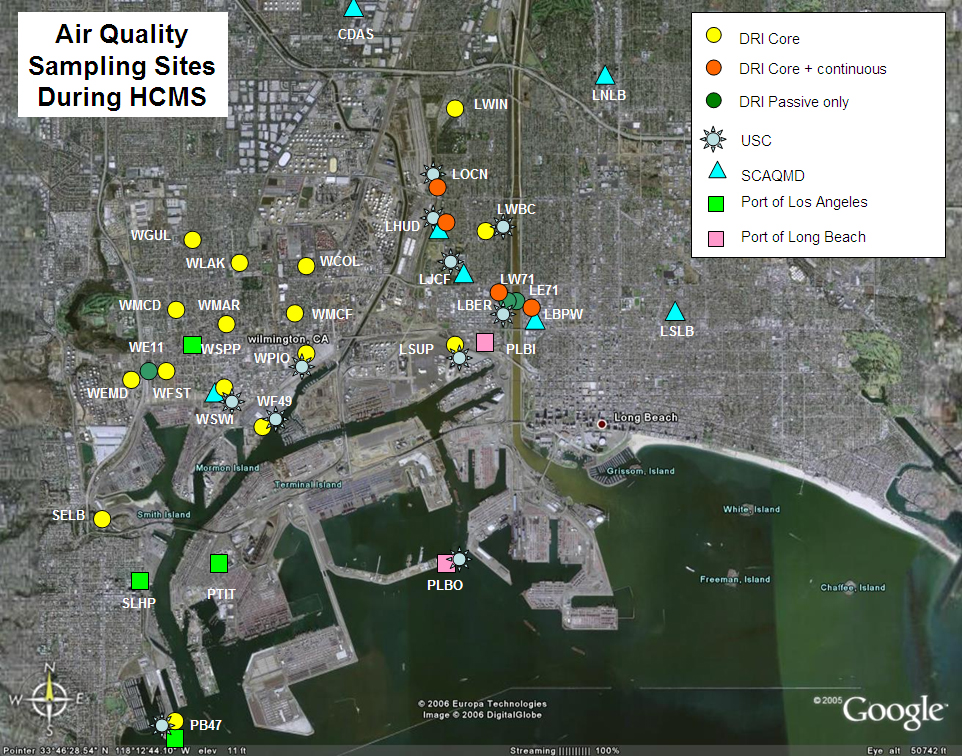Article Summary:
This page last reviewed March 12, 2015
This website contains information pertaining to the Harbor Communities Monitoring Study (HCMS), conducted to characterize air quality in the communities of the greater Wilmington area. The air pollution measurement phase occurred during 2007. The primary goal of this study is to characterize the spatial variations in air quality in this area having various large emission sources. The measurement program featured non-traditional monitoring tools to cost-effectively characterize pollutant concentrations in the area and to identify locales where pollutant concentrations are high. The measurements consisted of three types of air pollution sampling: a network of passive samplers, a mobile platform, and a network of particle counters (all described below). The sampling program helped to characterize the temporal and spatial variations of air pollution in the study region. Occasional meetings are held in Wilmington to keep the local communities informed of the progress of the study.
A Chair’s Air Pollution Seminar, featuring presentations by all three principal investigators of the Harbor Communities Monitoring Study, occurred Monday April 26, 2010. This seminar was held in Sacramento at the Cal/EPA Headquarters Building and was also webcast. To access the individual presentations or to see the videos of the webcast, please visit the Chair’s Air Pollution Seminar announcement.
The first presentation, by Professor Constantinos Sioutas of the University of Southern California, describes research efforts into the spatial and temporal variations in ultrafine particle number concentrations. The three components of this research included primary production of particles in the Harbor Communities, primary and photochemical production of particles in the Riverside area, and the influence of freeway sound walls on pollutant distributions.
The second presentation, by Professor Arthur Winer of the University of California, Los Angeles, describes research efforts to better characterize pollutant concentrations near mobile and stationary emission sources as well as activity patterns of motor vehicles and people. The primary objective was to better characterize the spatial and temporal variations in pollutant concentrations and activities so that human exposure estimates, particularly to diesel-related emissions, can be refined.
The third presentation, by Professor Eric Fujita of the Desert Research Institute, describes efforts to better characterize the intracommunity variations in both gaseous and particulate air pollutants, particularly pollutants with chronic health implications such as PM2.5 and toxic air contaminants. This research documented the accuracy of non-traditional methods (passive samplers and mini-volume samplers) and used them to cost-effectively evaluate the intra-community variations in pollutant concentrations.
Community Meetings
The next Community Meeting will be held in early 2011 after the three data collection and analysis contracts have concluded and the final reports are available.
Presentations from prior community meetings
Final Reports
Desert Research Institute – Saturation Study (Contract 05-304)
University of California, Los Angeles – Mobile Monitoring Studies (Contract 04-348)
University of Southern California – Particle Count and Sound Wall Studies (Contract 05-317)
Background
The communities being studied include Wilmington and parts of San Pedro, West Long Beach, and Carson. The fixed-location monitoring sites in operation during the HCMS and the group(s) conducting the sampling at each site are indicated on the map below.

These communities were chosen because of the various emission sources in the area and the close proximity of residents to these emission sources. The Harbor Communities are located just north of the Ports of Los Angeles and Long Beach, which handle 40% of all container traffic entering the United States; the area is also surrounded by some of the most heavily traveled freeways in Southern California, is home to several large refineries, and a number of rail facilities.
The pollutants being measured include, but are not limited to:
- Black Carbon
- Carbon Monoxide
- Nitrogen Oxides
- Particulate Matter
- Ultrafine Particles
- Volatile Organic Chemicals
- Hydrogen sulfide
These pollutants are defined in the Harbor Communities Monitoring glossary here or click on the pollutant names above. Standard meteorological measurements, primarily wind speed and direction but also other weather parameter data, are being collected to support the interpretation of the air quality data being gathered from the mobile monitoring platform and the fixed monitoring sites. Characteristic meteorological conditions in the greater Harbor Communities Monitoring Study area are presented on the HCMS Meteorological Summary Page (PDF – 996 KB). Meteorological data collected during the HCMS will be summarized and updated on this webpage from time to time.
The HCMS consists of the following three studies:
Saturation Monitoring using passive sampling (Desert Research Institute-DRI)
Mobile Monitoring Platform (ARB/University of California, Los Angeles)
Ultrafine particle network (University of Southern California)